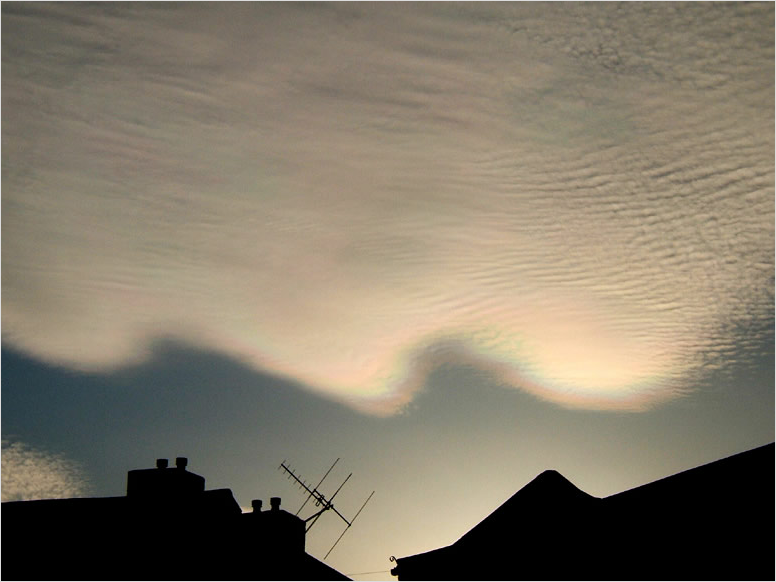Iridescence
Iridescence: A Colorful Phenomenon in the Sky
Have you ever gazed up at the sky and been captivated by the vibrant colors dancing within a cloud? This mesmerizing display is known as iridescence. While it may seem like magic, there is a scientific explanation behind this captivating atmospheric optics phenomenon. In this article, we will delve into the world of iridescence, exploring its causes, characteristics, and the various ways it can manifest in the sky.
What is Iridescence?
Iridescence refers to the phenomenon where certain surfaces or substances exhibit changing colors when viewed from different angles. In the context of atmospheric optics, iridescence occurs when sunlight interacts with tiny water droplets or ice crystals suspended in the atmosphere. These microscopic particles act as tiny prisms, refracting and scattering light in such a way that it separates into its component colors, creating a stunning display of hues.
Causes of Iridescence
The primary cause of iridescence in the atmosphere is the interference and diffraction of light waves as they interact with water droplets or ice crystals. When sunlight passes through these particles, it undergoes a series of reflections, refractions, and diffractions. This complex interaction causes the light to scatter and bend, resulting in the separation of colors and the formation of iridescent clouds or other atmospheric phenomena.
Characteristics of Iridescent Clouds
Iridescent clouds are one of the most common manifestations of iridescence in the sky. These clouds often appear as patches or bands of vibrant colors against a backdrop of white or gray clouds. The colors range from pale pastels to intense hues, depending on the size and arrangement of the water droplets or ice crystals.
Here are some key characteristics of iridescent clouds:
-
Colorful Bands: Iridescent clouds typically exhibit bands of colors, with each band representing a different wavelength of light. The most commonly observed colors include shades of red, orange, green, blue, and purple.
-
Dynamic Nature: Iridescence in clouds is a dynamic phenomenon that can change rapidly. As the angle of sunlight or the position of the observer changes, the colors and patterns within the cloud may shift or intensify.
-
Localized Effect: Iridescence is often localized within a specific area of a cloud, rather than occurring uniformly across its entire surface. This localized effect adds to the beauty and uniqueness of the phenomenon.
Types of Iridescence
Iridescence can manifest in various forms, each with its own distinct characteristics. Some common types of iridescence observed in the atmosphere include:
-
Cloud Iridescence: This is the most familiar form of iridescence, where vibrant colors appear within or around clouds. It is often seen in altocumulus, cirrocumulus, and lenticular clouds.
-
Corona Iridescence: Coronae are circular rings of colored light that surround the Sun or Moon. When these rings exhibit iridescence, they create a breathtaking display of shifting colors.
-
Rainbow Iridescence: Sometimes, rainbows can display iridescent colors at their edges, adding an extra touch of magic to these natural wonders.
Real-Life Examples
Iridescence is not just a rare phenomenon seen by a lucky few; it can be observed by anyone with a keen eye and a bit of luck. Here are a few real-life examples where iridescence has graced the skies:
-
Iridescent Clouds over Southampton, England: In April 2006, Lesley Jennings captured a stunning photograph of iridescence filling the sky over Southampton, England. The cloud displayed both small and large-scale wave structures, enhancing the beauty of the colors.
-
Iridescent Sundogs: Sundogs, also known as parhelia, are bright spots that appear on either side of the Sun. These spots can exhibit iridescence, creating a captivating spectacle in the sky.
-
Iridescent Rainbows: While rainbows are already a breathtaking sight, they can sometimes display iridescent colors at their edges. This phenomenon, known as rainbow iridescence, adds an extra layer of enchantment to the rainbow.
The Beauty of Iridescence
Iridescence is a reminder of the stunning natural wonders that surround us. From the vibrant colors within clouds to the shimmering rings around the Sun, this phenomenon serves as a testament to the intricate interactions between light and matter in our atmosphere. So, the next time you find yourself gazing up at the sky, keep an eye out for the captivating display of iridescence, and let yourself be awed by its ethereal beauty.

Iridescence over Southampton, England captured in April '06 by Lesley Jennings of Fraserburgh, Scotland.
The iridescence fills the cloud which has both small and large-scale wave structure.
©Lesley Jennings
Note: this article has been automatically converted from the old site and may not appear as intended. You can find the original article here.
Reference Atmospheric Optics
If you use any of the definitions, information, or data presented on Atmospheric Optics, please copy the link or reference below to properly credit us as the reference source. Thank you!
-
<a href="https://atoptics.co.uk/blog/iridescence/">Iridescence</a>
-
"Iridescence". Atmospheric Optics. Accessed on April 19, 2024. https://atoptics.co.uk/blog/iridescence/.
-
"Iridescence". Atmospheric Optics, https://atoptics.co.uk/blog/iridescence/. Accessed 19 April, 2024
-
Iridescence. Atmospheric Optics. Retrieved from https://atoptics.co.uk/blog/iridescence/.